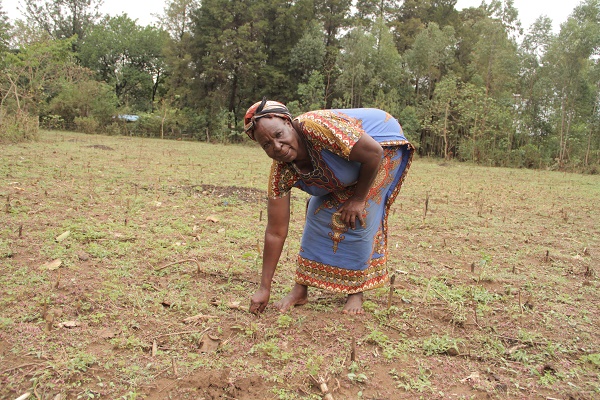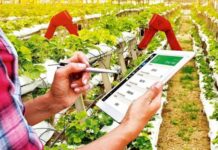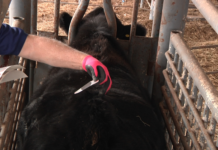To thousands of maize and beans farmers in Kenya a new low cost model of farming is improving their soil health and increasing their yields at a time when declining soil fertility, lack of access to inputs and increasing droughts has taken a toll on farm fields further fanning hunger and income insecurity.
To intensify food production and boost earnings for smallholder farmers in Kenya, the Sustainable Intensification of Maize-Legume Systems for Food Security in Eastern and Southern Africa (SIMLESA) project is promoting ‘conservation agriculture’ (CA)-based production techniques. Collaborating with over 235,000 farming households across eastern and southern Africa, the project aims to improve soil health and boost yields by helping smallholders to implement sustainable CA-based practices, such as minimum soil disturbance, crop residue retention and intercropping. To further promote productivity, SIMLESA also provides farmers with training in agronomy such as how to optimize the application of inputs like herbicides and fertilizer.
For 70 year-old Mary Nasimiyu Walukhu, a farmer from Bungoma County in western Kenya, the idea of preparing her land by spraying herbicide – as opposed to plowing the fields prior to planting – sounded too simplistic to be believed. Throughout her farming life she had adopted the traditional methods of plowing using oxen or tractor; however, with such resources in limited supply in her village, this often led to planting delays and, subsequently, chronic food shortages.
“People thought we were crazy when they saw us spraying our land and they warned us that we would damage our soils and get no harvest,” she said.
In 2012, Mary was invited to receive training from the SIMLESA project by a local agricultural extension officer from the county’s department of agriculture. Along with 25 other farmers, she learned the importance of minimal soil disturbance and to dig holes only where seeds were to be planted to reduce soil erosion. She also learned how to space her maize and legume seeds to optimize yields, as well as the correct application rates for manure and fertilizer to improve soil nutrient levels.
“People thought we were crazy when they saw us spraying our land and they warned us that we would damage our soils and get no harvest,” says Mary. But, in spite of her scepticism, she set aside 1 acre of her 2.5 acre farm to test the CA-based practices. From the first harvest after adopting the SIMLESA practices, Mary obtained 16 (90 kg) bags of maize, where previously, she would harvest just three bags. Following these promising results, Mary was conscious to apply the advised rates of manure and fertilizer when preparing her land for the next season and increased her harvest again to 22 bags. “My yields keep on increasing!” she exclaims.
Mary has also joined a SIMLESA ‘innovation platform’ (agricultural knowledge exchange and action forum). Being a part of this 30-member group has enabled her to afford inputs like herbicide, fertilizer and improved seeds at discounted prices as the group is able to buy in bulk collectively. According to Mary, the use of quality inputs has not only improved her yields, but has saved her time, labor and expense. “Labor saving is one of the key factors driving adoption of CA-based sustainable intensification technologies and practices. The other factor is that in using these technologies and practices, productivity is increased without compromising the ability of the environment to meet the needs of future generations,” explains Charles Nkonge, SIMLESA-Kenya country coordinator. “Under CA-based options, crops are grown without plowing or hand weeding. Herbicides are used instead and this results in large savings,” says Charles. Prior to the training, Mary would spend KSH 6,000 (US $60) on plowing services, but since using herbicides, she spends just KSH 1,000 (US $10) per acre.
“In using sustainable intensification practices, productivity is increased without compromising the ability of the environment to meet the needs of future generations,” Charles added.
As part of the innovation platform, group marketing has also enabled Mary to achieve a higher price for her maize. Before joining the group, she would sell a bag of maize for around KSH 1,800, but since bulk selling with the group, she is able to receive higher prices of between KSH 4,000-6,000 . As a result, Mary no longer relies on her husband for money and is able to contribute to her grandchildren’s school fees. With her increased earnings, Mary has also improved her nutrition security through the purchase of chickens to provide eggs for household consumption. She has also bought an Ayshire heifer, from which she aims to produce and sell milk to further increase her earnings.
“This (SIMLESA) project has really taken off and helped our farmers,” says Isaac Amusavi, an extension officer from Bungoma County government who has trained 2,000 farmers in CA-based techniques through SIMLESA. According to Isaac, since the project began in 2010, he has witnessed average maize yield increases from 5 to 18 (90 kg) bags per acre. For beans, yields have increased from 1 to 3-4 bags per acre. Bungoma County extension officers are also training farmers in best agronomic practices and post-harvest management for maize and legume crops to further improve yields and reduce food losses.









